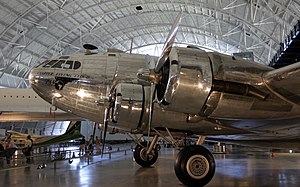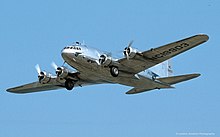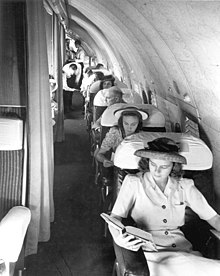Boeing 307
| Boeing 307 Stratoliner | |
|---|---|
 Restored Boeing 307 |
|
| Type: | Airliner |
| Design country: | |
| Manufacturer: | |
| First flight: |
December 31, 1938 |
| Commissioning: |
July 8, 1940 |
| Number of pieces: |
10 |

The Boeing Model 307 Stratoliner was a four-engine airliner produced by the American manufacturer Boeing . It was the first civil aircraft to be equipped with a pressurized cabin .
history
As early as 1937, the trade press reported in detail about Boeing's plans for a four-engine passenger aircraft with a pressurized cabin.
Pan American Airways and Transcontinental and Western Air no longerwanted towait forthe delayed development of the DC-4 from Douglas Aircraft Company , in which they were involved with American Airlines , United Airlines and Eastern Air Lines , and ordered the Model 307 with a larger onefrom BoeingRange, pressurized cabin and a projected summit height of 35,000 feet.
The first flight of the prototype with the registration number NX19901 took place on December 31, 1938. On March 18, 1939, this aircraft crashed 100 kilometers south of Seattle near Alder during a test flight with chief pilot Julius Barr .
The factory designations for the Model 307 differed from the previous Boeing practice, as both prefixes and the usual variant additions were used as suffixes. The four Pan Am machines were given the designation S-307 , or PAA-307 . The TWA's five aircraft were SA-307B and the single Hughes machine was designated the SB-307B .
construction
The four-engine 307 was built from 1938 to 1940 on the technical basis of the B-17 Flying Fortress bomber and offered 33 passengers space. The pressurized cabin made it possible to fly over bad weather areas and to use higher altitudes without the use of oxygen masks .
drive
Boeing used four nine-cylinder Wright GR-1820-G105A Cyclone radial engines , each with 900 HP (approx. 660 kW) continuous output and 1,000 HP (approx. 740 kW) take-off output. The engines were equipped with turbochargers and reduction gears for the adjustable three-bladed propellers from Hamilton Standard .
Fuselage and tail units
With the Model 307 , Boeing built the first pressurized cabin in series.
use
Only ten Stratoliner machines were built. The outbreak of the Second World War prevented this aircraft from being used on a large scale. It was used by the Pan Am and TWA airlines .
Technical specifications
| Parameter | Data |
|---|---|
| crew | 5 |
| Passengers | 33 |
| length | 22.66 m |
| span | 32.61 m |
| height | 6.34 m |
| Max. Takeoff mass | 42,000 lb (approximately 19,100 kg) |
| Cruising speed | 220 mph (approx. 350 km / h) |
| Top speed | 246 mph (approx. 400 km / h) |
| Service ceiling | 26,200 ft (approx. 8,000 m) |
| Range | 2,390 mi (approx. 3,850 km) |
| Engines | four nine-cylinder radial engines Wright GR-1820 Cyclone with 900 HP each (approx. 660 kW), each with 1 three-blade propeller |
Received aircraft
NC19903
The only completely preserved Stratoliner is in the Steven F. Udvar Hazy Center near Washington's Dulles International Airport .
This aircraft sank during the last test flight before the planned transfer to Washington (DC) on March 28, 2002 after a ditching due to lack of fuel in Elliott Bay in Seattle, Washington. After the recovery, the Flying Cloud was restored to an airworthy condition and then flown to the museum.
N19904
The hull of the N19904 is preserved as a boat cabin in Florida.
The former private plane ( The Flying Penthouse ) owned by Howard Hughes was acquired in 1969 by Kenneth W. London, who converted it into a motor yacht in Fort Lauderdale in July 1974 and named it "The Londonaire". In 1981 Dave Drimmer bought the yacht and named it "Cosmic Muffin" - after a houseboat in the novel Where is Joe Merchant? by Jimmy Buffett .
See also
Web links
- Entry on the Boeing 307 in the online encyclopedia Historylink
- Aviation History: Boeing 307 Stratoliner
- Commercial film by the then TWA about the Boeing 307
- Boeing 307 Stratoliner at FliegerWeb.com
Individual evidence
- ↑ a b Nascent Giants. (PDF) America Develops a Four-Engine Complex: Sub-Stratosphere Services in Sight: An Ambitious Program by Boeing. In: FLIGHT, APRIL 8, 1934. Flightglobal.com , April 8, 1937, p. 347 , accessed July 23, 2017 .
- ↑ a b Model 307 Stratoliner. In: History. Boeing, 2017, accessed October 25, 2019 .
- ^ Bob Walter: Remembering Boeing Stratoliner Prototype Crash Near Alder. Ten Men Killed March 18, 1939. In: Eatonvillenews.net. Eatonville News, January 18, 2015, accessed on July 25, 2017 (interview with contemporary witnesses).
- ↑ Peter M. Bowers: Boeing Aircraft since 1916 , Putnam & Co., 1989, p. 230 f.
- ↑ Wright Cyclone GR-1820-G105A, Radial 9 Engine. In: National Air and Space Museum. Smithsonian Institution, accessed on July 30, 2017 (English): "Besides the DC-3, the Wright Cyclone GR-1820-G102 through -G109 series powered a number of aircraft, including the: Boeing 307 / B [...]"
- ↑ a b Bryan R. Swopes: December 31, 1938. In: This Day in Aviation. Retrieved July 24, 2017 .
- ↑ a b Boeing 307 Stratoliner "Clipper Flying Cloud". In: National Air and Space Museum. Smithsonian Institution, accessed July 24, 2017 .
- ^ Accident description. Boeing S.307 Stratoliner. In: Database. Aviation Safety Network, July 22, 2017, accessed July 23, 2017 .
- ↑ Ellen Whitford: Once more with feeling. In: Boeing Frontiers Online. The Boeing Company, September 2003, accessed December 30, 2011 .
- ^ Daniel Flahiff: The Cosmic Muffin: A Boat Recycled From Howard Hughes' Plane. Inhabitat.com, August 20, 2009, accessed December 30, 2011 .
- ^ Transformation - Plane to Boat. Plane Boats, accessed December 31, 2011 .

